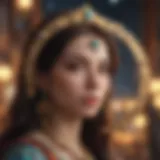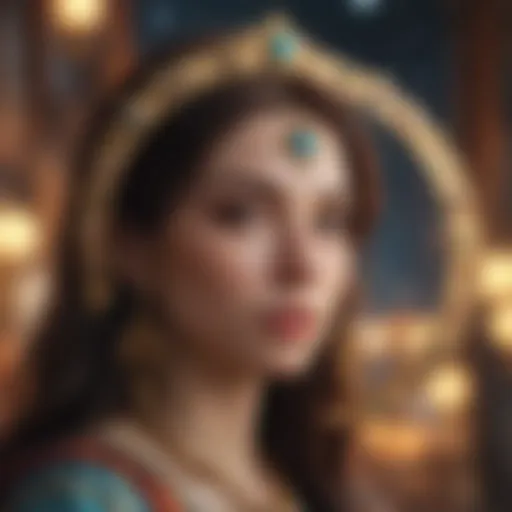Unlocking Insights: Free 10 Card Tarot Reading Guide
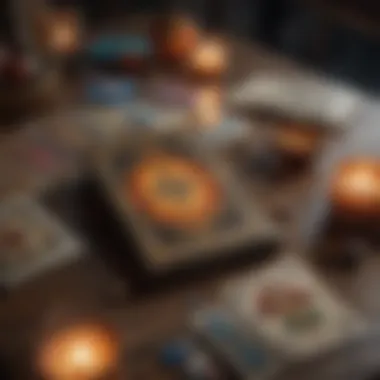

Intro
Tarot reading has gained a significant foothold in both personal development and esoteric exploration. Many see it as a way to gain insights that are often elusive. This guide aims to delve into free tarot readings specifically using a 10 card spread. Each card's placement holds importance, contributing to a comprehensive interpretation of individual circumstances and questions.
By understanding how to navigate this mystical practice, readers from various backgrounds can enhance their self-awareness and decision-making. The content is tailored for both novices interested in learning the basics and seasoned practitioners looking to refine their skills or explore new insights into their readings.
This article outlines the necessary aspects of a tarot reading, including the meanings of card placements, key interpretative strategies, and some benefits of engaging with tarot as a reflective tool. We will also discuss how online platforms can foster community interactions that enhance the learning experience.
Foreword to Tarot and Its Importance
Understanding Tarot begins with recognizing its profound significance in personal and spiritual development. This section outlines what Tarot is and why its importance goes beyond mere fortune-telling. Tarot serves as a bridge between the conscious and subconscious mind, facilitating self-awareness and introspection.
Definition of Tarot
Tarot is a deck of 78 cards, each with its unique imagery, symbolism, and narrative. It comprises the Major Arcana, which details significant life themes, and the Minor Arcana, which focuses on day-to-day events. Each card in the deck serves as a mirror, reflecting aspects of oneself or one’s circumstances. Tarot is not just about predicting the future; its richness lies in exploring one’s inner landscape through nuanced imagery and meanings.
The Historical Context of Tarot
The history of Tarot is complex and multifaceted. Emerging in late 14th century Italy, Tarot was initially used for playing card games. Over centuries, it evolved into a tool for divination and psychology. Scholars often trace its roots back to ancient civilizations, linking its imagery to various esoteric traditions, including Kabbalah and alchemy. Understanding this historical backdrop adds depth to the modern practice of Tarot, highlighting how its symbols have transcended time and culture, enriching emotional and spiritual exploration.
Tarot as a Tool for Insight
Tarot serves as a powerful instrument for gaining insights. Through its structured spreads, such as the 10 card spread, individuals can explore their past, present, and future, as well as their internal and external influences. Each card's position holds a narrative thread, weaving together a story that clamors for attention. In this way, Tarot becomes a form of self-therapy, offering guidance while encouraging critical reflection. Engaging with Tarot invites users to confront their fears, aspirations, and desires, ultimately paving the path for personal growth.
"Tarot does not predict the exact outcome but helps illuminate possible futures and choices."
In summary, this initial exploration sets the stage for a deeper understanding of how cards work and their significance in the larger context of personal development. Tarot, when used mindfully, acts as a compass guiding individuals toward self-discovery and clarity.
Understanding the Card Spread
The 10 card spread is a popular and intricate method used in tarot readings. It serves many purposes, from providing guidance to revealing deeper insights about a person’s life, experiences, and future. Understanding this spread is essential for anyone interested in utilizing tarot for personal reflection or as a tool in their practice. By diving into how each card position functions within the spread, readers can gain clarity and direction in their circumstances.
Overview of Card Spreads
Card spreads are predetermined layouts for laying out tarot cards. Each spread can carry its own significance depending on the number of cards used and their specific positions. The beauty of tarot lies not only in the cards themselves but also in how they are arranged.
- Card spreads help the reader focus on the question or issue at hand.
- They allow for a deeper understanding by illustrating different aspects of a situation.
- Each position in a spread corresponds to a specific area of life, whether it be past influences, current conditions, or future possibilities.
The 10 card spread, like many others, organizes cards logically to provide a more extensive picture of the questions posed during a tarot session. This structure offers both clarity and a broader context, essential for meaningful interpretation.
Specifics of the Card Spread
The specifics of a 10 card spread can seem complex, but breaking it down simplifies its understanding. Each card's position corresponds to distinct aspects of the seeker’s journey. Typical positions in a 10 card spread include:
- Past: This card reflects what has previously occurred, influencing the present situation.
- Present: It indicates the current emotional or situational state of the querent.
- Future: This suggests potential outcomes based on current actions.
- Internal Influences: It reveals the seeker’s inner thoughts and feelings affecting their circumstances.
- External Influences: This card illustrates outside factors impacting the seeker’s life.
- Hopes and Fears: It conveys what the querent desires or dreads in their journey.
- Advice from the Universe: This position offers guidance that can lead to better outcomes.
- Outcome: This projects final results, contingent upon the current path.
- Spiritual Guidance: Reflects the influence of spiritual or intuitive direction.
- Final Outcome Overview: Summarizes the overall situation, providing closure or clarity.
Each position demands careful consideration during a reading. The card and its meaning must be analyzed not only individually but also in the context of the entire spread. This holistic approach fosters deeper comprehension, ensuring tarot remains a powerful instrument for insight and reflection.
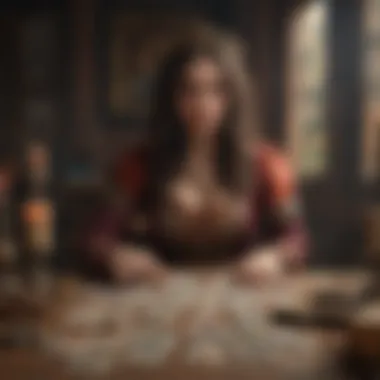

"A well-understood card spread unlocks the true potential of tarot readings, revealing layers often overlooked in simpler layouts."
Overall, the 10 card spread invites a multifaceted view of a person's journey, enhancing the reader's ability to facilitate meaningful discussions and provide valuable insights.
Card Positions in the Card Spread
The card positions in a 10 card spread play a crucial role in tarot reading. Each of the ten positions has a specific significance that helps shape the reading's context, providing clarity and insight into the querent's life. Understanding these positions thoroughly enhances the interpretation process, allowing readers to extract deeper meanings from the cards drawn. Recognizing how each card relates to its position can uncover patterns and illuminate paths not initially visible. Readers can gain more than just surface insights; they can explore intricate connections that exist between past, present, and future.
Position One: The Past
This position reveals events or influences from the past that are affecting the current situation. It can showcase lessons learned or patterns that repeat in the querent's life. Understanding this past context is vital as it can explain why certain challenges arise. A card here needs careful consideration. For example, if the Six of Cups appears, it might suggest nostalgic feelings impacting decisions today, pointing towards a person or memory that continues to influence actions.
Position Two: The Present
The present card indicates the querent's current circumstances. It represents what is happening in the moment and can highlight immediate challenges or opportunities. This card reflects the querent’s reality and current mindset. If the Two of Swords is drawn, it may indicate a decision that needs to be made, showcasing a period of indecision or confusion. Hence, this position is essential for anchoring the reading in the present moment.
Position Three: The Future
This position projects possible outcomes based on the current path. It is important to understand that the future is fluid and can change with different choices. A card like the Wheel of Fortune here may signal change and unpredictability, indicating that the querent should be prepared for shifts that can bring new opportunities or challenges. It prompts readers to emphasize the need for awareness of their actions today that shape tomorrow.
Position Four: Internal Influences
The fourth position reveals the querent's internal state, including thoughts, emotions, and subconscious influences. This position can reflect the querent’s desires, fears, or doubts. Drawing the Five of Cups here might indicate grief or dissatisfaction that hinders progress. Awareness of these internal factors is crucial for personal growth and navigating challenges effectively.
Position Five: External Influences
External influences encompass situations or people that impact the querent's life. This position can reveal societal pressures, relationships, or physical environments that play a role in current challenges. For instance, the Three of Pentacles could suggest collaboration or teamwork is vital right now, emphasizing the importance of support systems. It’s essential to consider how these outside forces shape decisions and define circumstances.
Position Six: Hopes and Fears
This position uncovers the querent’s hopes and fears about the future. It is a space that connects ambitions with worries, revealing inner conflicts. If a card such as the Nine of Swords comes up, it might highlight anxieties regarding an impending decision. Here, understanding the balance between desire and fear can help the querent make informed choices moving forward.
Position Seven: Advice from the Universe
Here, the cards offer guidance aimed at the querent. It can reflect the universe's direction and support available. If the The Hierophant appears, it may suggest seeking traditional wisdom or guidance from a mentor. This position serves as a reflective mirror that encourages alignment with one's higher self and intuition.
Position Eight: The Outcome
This outcome position indicates what may happen if current trajectories are maintained. However, it is not fixed and can change with new actions or decisions. A card like the Sun here signifies positive outcomes, revealing success and joy. It serves as both motivation and a caution to remain proactive in shaping one’s destiny.
Position Nine: Spiritual Guidance
Spiritual guidance highlights insight that transcends the material world, offering deeper understanding or lessons. It can reflect spiritual growth or enlightenment. If the Judgment card is positioned here, it might signify the need for reflection and evaluation of past actions for personal evolution. Recognizing spiritual lessons can enhance overall clarity in one’s tarot journey.
Position Ten: Final Outcome Overview
The final card provides a synthesis of the reading, summarizing key aspects and highlighting crucial takeaways. This position encapsulates the primary message drawn from the reading, enabling readers to grasp what has been learned. A card such as the World may suggest completion and achievement, reinforcing a journey’s ending while opening doors to new cycles. The final outcome serves as a closing reflection, allowing one to comprehend the path ahead.
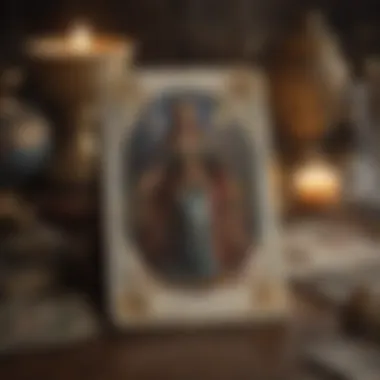

This detailed understanding of each position within a 10 card spread helps both novice and seasoned readers draw more insightful, personalized interpretations, connecting layers of meaning that can deeply resonate.
Interpreting the Card Spread
Interpreting the 10 card spread is a crucial aspect of tarot readings. This spread allows for an in-depth analysis of various elements in one's life. Each position in the spread has a specific meaning, guiding the reader to discern the relationships between different influences. Understanding these connections provides clarity in complex situations. Therefore, an effective interpretation can lead to profound insights and greater self-awareness.
Analytical Techniques
Analytical techniques involve structured methods to interpret the findings from the cards. Some common techniques include:
- Card Combination Analysis: Look at pairs or groups of cards to see how they relate to each other. For example, if the Two of Cups appears with the Ten of Swords, it might signify contrasting feelings in a relationship.
- Numerical Significance: Each number in the tarot has specific meanings. The sum or significance of card numbers can provide additional insights. For instance, the number seven often relates to introspection, while the number ten can indicate completion.
- Symbolic Meanings: Take note of the symbols in each card. Many cards possess traditional meanings that can be unlocked through deeper study. For example, the imagery of the moon can symbolize intuition, while the sun may indicate clarity and joy.
Using these techniques systematically can enhance readings. It encourages a reader to delve deeper into card meanings while analyzing how these meanings interact within the spread. Engaging with analytical tools can lead to clearer and more meaningful interpretations.
Intuitive Approaches
Intuitive approaches focus on the reader's personal feelings and spontaneous insights about the cards. This method embraces inner knowledge and emotional wisdom. Here are some elements to consider:
- Personal Resonance: Trust your gut feeling when interpreting cards. For instance, a card like the Tower might evoke strong emotions or past memories. These personal connections can steer interpretations in insightful directions.
- Meditation on the Cards: Spend time in quiet reflection with the cards before beginning a reading. This practice can help in forming intuitive connections to the cards, fostering revelations that may not spring from analytical thoughts alone.
- Dream Analysis: For those open to this, dream symbols can interact with tarot cards. A dream about a specific card can signal its importance in a reading. Connecting dreams with tarot readings can deepen understanding.
The fusion of intuitive and analytical methods offers a holistic view. Readers who adapt both approaches can gain enhanced clarity and embody a more comprehensive understanding of the insights presented by the cards.
The combination of analytical techniques and intuitive approaches provides a balanced perspective, enriching the interpretation of the 10 card spread.
Benefits of Free Tarot Readings
Tarot readings present a unique opportunity for individuals to engage with their inner selves and explore personal challenges without the barrier of financial costs. Free tarot readings, especially utilizing a 10 card spread, can serve as profound tools for insight and reflection. This section explores the multifaceted benefits of free tarot readings, emphasizing accessibility and the encouragement of personal growth.
Accessibility of Online Tarot Tools
In today’s digital age, the accessibility of online tarot tools has revolutionized how people engage with tarot. Numerous websites and applications provide free tarot readings, making it easier than ever to access this ancient practice. People can use platforms like Biddy Tarot or Tarot.com from the comfort of their homes.
Anyone with an internet connection can find resources that offer readings, interpretations, and tips. This accessibility democratizes tarot, enabling individuals who previously might not have sought readings to explore their spiritual and emotional landscapes easily.
Online tarot tools often feature intuitive designs, allowing users to shuffle virtual decks and draw cards with just a click. This immediacy aids users in tapping into their intuition and thoughts more freely. Many sites also provide comprehensive explanations for each card and position in the spread, catering to both novices and seasoned practitioners alike.
Encouragement of Self-Reflection and Growth
Engaging with tarot cards fosters a deeper understanding of oneself. Free tarot readings promote self-reflection by prompting users to contemplate their current circumstances, desires, and fears. As users interpret the cards, they often uncover hidden aspects of their lives. This process can lead to realizations about personal patterns and behaviors, encouraging growth and development.
The 10 card spread, in particular, is designed to reveal various influences in one's life including past experiences, present circumstances, and potential future outcomes. It allows users to see how their internal and external influences converge. By facilitating this self-examination, tarot readings can motivate individuals to take actionable steps toward change or affirmation of their journeys.
Self-reflection prompted by tarot can redefine personal goals and instill confidence in decision-making.
Furthermore, regular engagement with tarot may lead to heightened intuition. This connection to one's inner guidance can empower individuals, fostering resilience amidst life's uncertainties. Each reading can serve not only as a moment of clarity but also as a catalyst for ongoing personal exploration and understanding.
Resources for Learning Tarot
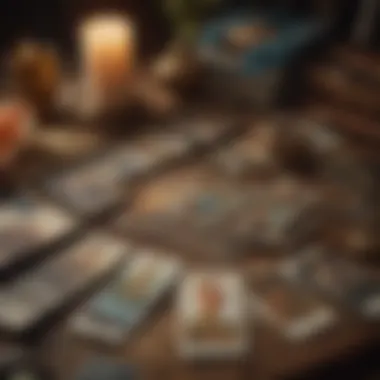

Learning tarot requires more than just picking up a deck and beginning to shuffle. The journey into understanding tarot is complex and layered. This section discusses the resources available for anyone eager to develop their tarot skills. It highlights the importance of engaging with the right materials and communities, which can significantly enhance one's proficiency in tarot reading.
Access to diverse resources promotes varied learning styles. Some people learn best through interactive experiences, while others prefer reading and reflection. A well-rounded approach typically combines different methods, making the journey into tarot both enriching and fulfilling. Below we explore two key areas where learners can deepen their knowledge: online platforms and literature.
Online Platforms and Communities
In today's digital landscape, tarot enthusiasts have a wealth of online resources at their fingertips. Websites and platforms dedicated to tarot reading offer a plethora of information. These include sites featuring card meanings, forums for discussion, and video tutorials.
Benefits of Online Platforms:
- Access to real-time feedback through community discussions
- A broad selection of tutorials that cater to varying levels of experience
- Opportunities for networking with other tarot readers
One popular online resource is Reddit, where numerous communities focus on tarot. Users can share personal readings, ask for interpretations, and learn from seasoned practitioners.
Another option is Facebook groups dedicated to tarot. These groups often foster supportive environments where members share experiences, tips, and resources. Remember to engage actively to benefit from the communal knowledge.
Books and Literature on Tarot
Books provide a foundation for understanding tarot's rich history, symbolism, and intricacies. Numerous authors have illuminated various aspects of tarot reading. Selecting a few reputable texts can help guide a novice through the complex world of tarot.
When considering literature for tarot study, focus on the following:
- Classic texts like The Book of Tarot by Alison McCabe often provide a comprehensive introduction.
- Look for interpretive guides such as Rachel Pollack's 78 Degrees of Wisdom, which explores each card's meaning in depth.
- Practice-oriented books can guide readers through exercises and spread interpretations.
"A good tarot book will not only explain each card but also provide insights on the art of reading them in context and developing personal intuition."
By engaging with both online resources and literature, learners can cultivate their tarot skills, enhancing their understanding and connection to the cards. The wealth of information available enables anyone to navigate the tarot realm thoughtfully and confidently.
Concluding Thoughts on Tarot and Free Readings
The realm of tarot is intricate and multifaceted. As we conclude this exploration, it is crucial to recognize the profound impact that free tarot readings can have on individuals seeking insight. Firstly, these readings serve not just as a means of divination, but also as a path for personal growth and understanding. The knowledge gained through a ten card spread can lead to transformations in one’s perspective, allowing for more informed life choices and increased emotional awareness.
Reflections on Personal Growth
Tarot cards, each bearing unique symbols and meanings, provide an opportunity for introspection. With a ten card spread, various aspects of one’s life are illuminated. Participants often report a sense of clarity after interpreting their readings. This clarity fosters a greater understanding of personal strengths and weaknesses.
Many find that engaging with tarot encourages deeper self-reflection. Consider the following benefits:
- Enhanced self-awareness - Understanding current states and patterns.
- Guidance in decision-making - Making choices based on more comprehensive perspectives.
- Encouragement of mindfulness - Promoting the practice of being present in one’s own life.
Taking time to digest what each card represents can lead to meaningful realization. Thus, the act of reading tarot transcends entertainment; it transforms into an essential tool for psychological growth.
The Role of Tarot in Everyday Life
Incorporating tarot into daily life allows individuals to navigate complexities with greater ease. Regular engagements with tarot, even in casual settings, can cultivate a habit of reflection. It becomes part of a broader wellness routine that blends curiosity with mindfulness.
Here are a few ways tarot can play a role in everyday routines:
- Daily draw - Pulling a single card each morning can set the tone for the day.
- Themed spreads - Tailoring spreads to specific topics or questions can offer focused guidance.
- Journaling - Documenting insights from readings fosters long-term understanding.
"Tarot is not just about fortune telling; it's about self-discovery and growth."
Utilizing tarot to address life's dilemmas can empower individuals. As people familiarize themselves with card meanings and interpretations, they position themselves to respond rather than react to life's challenges. Through this practice, tarot can guide toward a more deliberate and enriching life experience.
Overall, the concluding thoughts on tarot and free readings emphasize their value as introspective tools. The act of turning to tarot for guidance enriches the journey of self-discovery while adding layers to our understanding of human experience.
